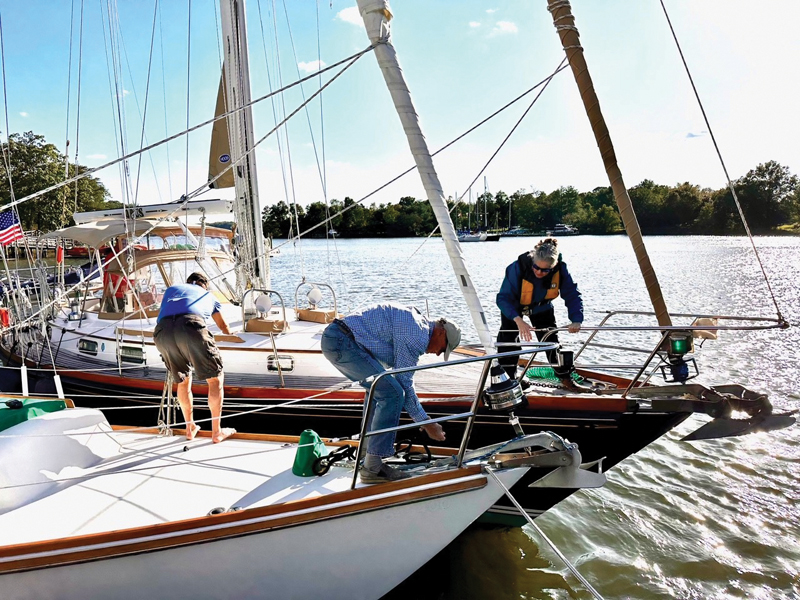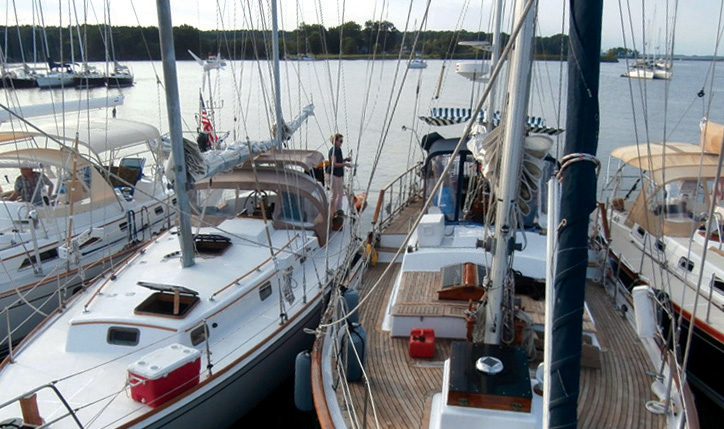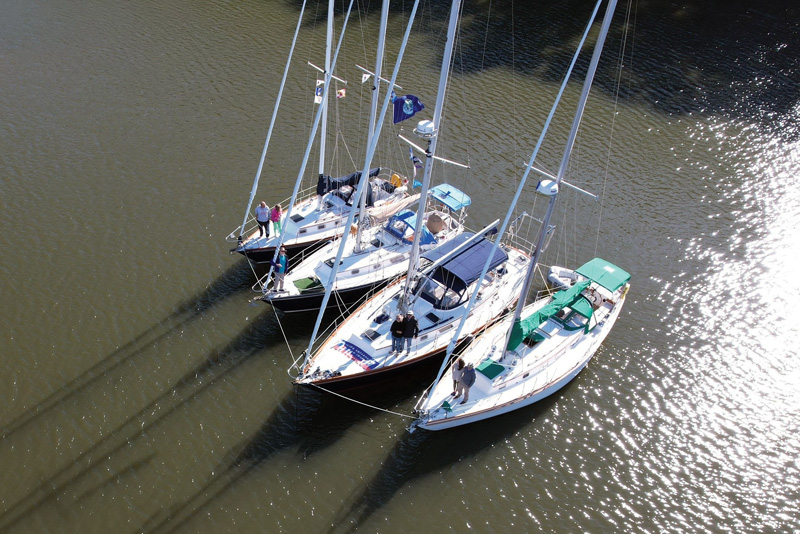Ready to raft up your sailboat?
For socially oriented sailors, raft up parties are some of the best parts of summer cruising. If you're new to rafting boats, you'll want to do all you can to ensure that your floating party doesn't end up drifting with the wind and current or get tangled up in an embarrassing, or dangerous, mess.
For some tried and true rafting tips, we reached out to a few Chesapeake cruising sailors with lots of rafting experience. Here are their recommended tips and pointers.

Start with the anchor boat.
Generally, the largest, heaviest boat should be the anchor boat, also called the host boat or mother ship. Ideally, the anchor boat will make sure that its anchor is set and holding for a period of time before accepting a raft boat. Occasionally when traveling with a group this is not possible, but most often it can be accomplished and will add a layer of confidence.
Anchor dragging incidents and swing radius increase with rafting, so before setting the host boat, make sure you have enough distance from other boats and objects. Be aware of your surroundings to anticipate any issues. A seven-to-one scope with a good flat entry is the minimum, but for a raft consider 10 to one, because you’ll have extra weight.
Larger rafts can put an enormous strain on the single anchor securing the raft, and even a modest wind accompanied by a shift can lead to late night “fire drills.” The anchor boat captain is the final authority on how many boats he or she can accept. As a point of reference, the Hunter Sailing Association-1 limits individual rafts to five boats and the Chesapeake Bristol Clubrecommends that no more than seven boats raft overnight.

Add the rafting boats.
The anchor boat determines if an approaching boat should raft on the port or starboard side and should put fenders in place to indicate on which side they will accept the rafting boat. VHF radio contact is good to indicate intentions and to clearly give instructions prior to approach.
Rafting boat captains must decide for themselves whether it is safe to join the raft, and if it is, maneuver at slow speed. This prevents the need for rapidly backing down and the associated “prop walk” that can cause your boat to move into the boat you are trying to raft with.
The approaching boat should be ready to supply the fenders and the lines to tie up, and the host captain or crew should be standing by prepared to take the rafting boat’s lines, beginning with the forward spring line. The best practice is to have bow line, stern line, and two spring lines. Never use the loop end of a line on a cleat. If a storm brews and you need to untie in a hurry, heavy winds pushing on the lines could prevent the removal of the line, resulting in the need to cut it loose. Skip the loop and tie up with the usual cleat hitch (two rivers and a bridge).
The most important factor when rafting sailboats is to ensure that the masts are offset such that any wake on the raft will not cause the masts and shrouds to “lock up.” To accomplish this, the rafting boat’s spreaders should be several feet (at a minimum) forward or aft from the host’s spreaders. Usually, the anchor boat is somewhat forward. If possible, align the lifeline gates, though this is not always practical. In any event, try to keep lines clear of lifeline gates to ensure safe access and reduce tripping hazards.

When it’s time to de-raft.
Conditions can change quickly on the water, and it is more difficult to break up a raft safely once conditions worsen. Check your forecast and wind conditions prior to deciding to raft and plan to de-raft well before the arrival of any questionable weather. It is always best to make the decision to de-raft early in anticipation of poor conditions. The adage “better safe than sorry” applies.
Are you rafting just for the afternoon, or will you remain tied together overnight? Generally, it is best to de-raft and anchor alone for the evening, unless the weather forecast is for very benign conditions in a protected cove or anchorage. De-rafting in the dark, or once strong winds and/or heavy rain are present, can be difficult and even dangerous. Preventing a hazardous situation is the watchword for keeping you, your crew, and your vessel safe.
Speaking of preventing a hazard, someone should always be on both ends of a line when loosening and breaking away. A loose line in the water could easily snag someone’s prop.

More best practices.
- For everyone’s safety and comfort, boats that may run their generator during the raft should consider keeping the exhaust side clear of another boat.
- Always keep the key in the ignition during a raft so that you can respond quickly during an emergency.
- Protect your freeboard by using plenty of fenders, and make sure they’re big enough to keep the rafted boats from “crunching.” Place fenders so that midship and stern are close together for ease of walking between boats.
- When walking over boats, it is considered impolite to go through the cockpit unless invited to do so. One should walk around over the bow to get to the next boat.
These tips and the recommended coves and creeks come courtesy of Hank Theuns, Rich Tull, and Leigh Seaver, founders of Compass Boating Club of the Chesapeake; Nancie Merritt of the Jeanneau Sailboat Owners club, and Dan Breitenbach, secretary of the Hunter Sailing Association, Station 1.
For a suggestions on how to build a sunflower raft, visit spinsheet.com/how-build-sunflower-raft.




